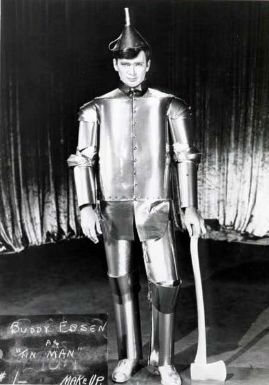April, 2014
Ten Tin Facts
Everyone has heard about the Tin Man, from "The Wizard of Oz," right? However, did you know that, despite what that story maintains, tin does not rust? Iron does, but the story would somehow have a different quality if they called him "Iron Man." That label needed to wait another one to four thousand years after the smelting of tin for a rather dissimilar type of movie.
I wonder how the first wizards of those distant times figured out how to get tin out of the earth, process it, and mix it with copper just the right way, so people could then make pots and weapons of the resulting alloy, bronze, ushering in a new (middle) age of mankind. It would fit neatly between the Stone and Iron Ages. Depending on the peoples, their relative isolation, and the geography, the Bronze Age began roughly 3300 BC (Middle East), 3000 BC (south Asia), 2300 BC (Europe), 2000 BC (China), and 1100 AD (the New World, which had the least cultural mixing). 
Buddy Ebsen's first make-up screentest as The Tin Man (Wikipedia) |
Tin whistles, tin cans, Rin Tin Tin, tin soldiers, tin foil, and Tin Pan Alley notwithstanding, many of us are little acquainted with tin. Here are a few interesting bits of trivia about this usually malleable metal:
- Tin's chemical symbol from the Periodic Table is Sn, based on its Latin name, Stannum. It is no. 50 on that chart, having 50 electrons and protons (and so 50 is its atomic number). It has the largest number of stable isotopes (10) of any element.
- Cassiterite is the ore from which most tin has been derived. It was often smelted by ancients using coal fires.
- These days, 35 countries produce tin, though China is by far the most important tin processor.
- Tin can be alloyed with niobium to create a superconductor, for which it is used to create magnets that have quite high field strength yet require little energy.
- When alloyed with copper and antimony, it results in a very durable metal useful as bearings.
- Since it is rather inert, tin is used in a number of coatings of other materials, such as steel, lead, and zinc, and for the metals used in water distillation.
- Tin is quite rare, occurring in only two parts per million of Earth's crust.
- Stannous fluoride is a tin compound used in most modern toothpaste to help prevent cavities.
- A common use for tin now is in solder, replacing lead-based solder which can have adverse health effects.
- Tin's uses are going up, for instance in the manufacture of window glass (the molten glass being floated on molten tin), as a coating to prevent corrosion, in alloys with copper of bronze, in organ pipes, and in die casting, yet supplies are running out. With rising rates of depletion, we could have exhausted the world's supply in only the next generation or two. Meanwhile, its price is likely to keep rising. Competition for the vital element could again become fierce. In ancient times, Britain was invaded by the Romans partly to secure this as a relatively good source of tin and other metals. Thus, besides its modern practical functions, tin's importance extends to the long-term effects of Roman colonization on the development of Western Civilization.
|
